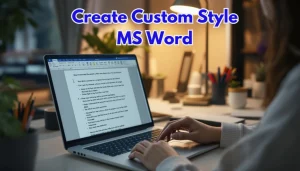Last Updated: January 24, 2025
Keyboard shortcuts in Microsoft Word can be game-changers for anyone looking to boost their productivity. While the default shortcuts are useful, customizing them to suit your unique workflow can take your efficiency to the next level. Imagine seamlessly navigating through Word, executing tasks in mere seconds without having to lift your fingers from the keyboard. Sounds impressive, right? Well, that’s exactly what we’re going to explore in this article.
You don’t have to be a tech wizard to make these adjustments; it’s surprisingly straightforward to customize keyboard shortcuts in Microsoft Word. We’ll walk you through the process step-by-step, from accessing the customization menu to tailoring shortcuts for your most frequent actions. Along the way, we’ll provide some tips and best practices to help you make the most out of this feature.
Whether you’re a seasoned Word user or just getting started, learning how to customize keyboard shortcuts can dramatically enhance your workflow and save you valuable time. Let’s dive in and unlock the full potential of Microsoft Word one shortcut at a time!
Table Of Contents
- 1 The Importance of Keyboard Shortcuts for Productivity
- 2 What Will Be Covered in This Guide
- 3 Why Customize Keyboard Shortcuts in Microsoft Word?
- 4 Accessing the Keyboard Shortcuts Customization Menu
- 5 Specific Examples of Custom Shortcuts
- 6 Emphasis on Customizing Keyboard Shortcuts
- 7 Tips and Best Practices for Effective Shortcut Customization
- 8 Conclusion
The Importance of Keyboard Shortcuts for Productivity
Mastering keyboard shortcuts in Microsoft Word can significantly improve your productivity and efficiency. Imagine navigating through your documents faster, transforming complex tasks into simple keystrokes, and reducing your dependency on the mouse. Whether you’re a casual user or a professional writer, knowing how to customize keyboard shortcuts in Microsoft Word can streamline your workflow and save you valuable time.
Using shortcuts can drastically reduce the time it takes to perform repetitive tasks. According to a study by Brainscape, users can save up to 8 days of work per year by using shortcuts. For writers, editors, and anyone who spends a lot of time on documents, this is an invaluable time-saver.
What Will Be Covered in This Guide
In this comprehensive guide, you’ll learn how to customize keyboard shortcuts in Microsoft Word to suit your personal and professional needs. We will walk you through the following:
1. Accessing the Keyboard Shortcuts Customization Menu
The first step in customizing your shortcuts is knowing where to find the settings. This involves navigating through the Word interface to access the customization options. We’ll give you detailed instructions with visual aids to make this step as simple as possible.
2. Examples of Common Shortcuts to Customize
We’ll provide a list of shortcuts that users commonly customize, such as bolding text or inserting headers. By tailoring these to your workflow, you can optimize Word to your unique preferences.
3. Tips and Best Practices
Finally, we’ll share some expert tips and best practices for choosing efficient shortcuts. This section will also include advice on avoiding conflicts with existing shortcuts and using advanced options like macros and custom commands.
Why Customize Keyboard Shortcuts in Microsoft Word?
Customizing keyboard shortcuts in Microsoft Word allows you to craft a personalized experience that enhances productivity. Here are a few key reasons why you should consider customizing your shortcuts:
- Increased Efficiency: Custom shortcuts can eliminate the need for repetitive actions, accelerating your workflow.
- Personalization: By assigning shortcuts that make sense to you, navigating Word becomes intuitive and tailored to your needs.
- Reduced Strain: Less reliance on the mouse can alleviate physical strain, a common issue for frequent computer users.
Understanding how to customize keyboard shortcuts in Microsoft Word is not just a luxury but a necessity for maximizing your productivity potential. Let’s dive into the specifics and start optimizing your Microsoft Word experience today!

Accessing the Keyboard Shortcuts Customization Menu
Customizing keyboard shortcuts in Microsoft Word is a simple process that starts with accessing the appropriate menu. Below are detailed instructions on how to navigate to the keyboard shortcuts customization interface.
- Open Microsoft Word: Start by launching Microsoft Word. Ensure you have a document open so that you can see all menu options.
- Navigate to the File Menu: Click on the File tab located at the top-left corner of the window.
- Access Options: In the File menu, scroll down and click on Options. This will open the Word Options dialog box.
- Customize Ribbon: In the Word Options dialog box, select Customize Ribbon from the left sidebar.
- Keyboard Shortcuts: At the bottom-left of the Customize Ribbon window, click on the button labeled Customize… next to Keyboard shortcuts. This will open the Customize Keyboard dialog box.
Screen Captures for Visual Aid
While screen captures are not included here, they can significantly aid in understanding. Visual guides can simplify navigation and enhance comprehension, making it easier for users to follow along and customize keyboard shortcuts in Microsoft Word effectively.
Specific Examples of Custom Shortcuts
Once you have accessed the Customize Keyboard dialog box, you can begin customizing your shortcuts. Here are some common Microsoft Word shortcuts that users might find useful to change based on their workflow needs.
| Command | Default Shortcut | Suggested Custom Shortcut |
|---|---|---|
| Save Document | Ctrl + S | Alt + S |
| Bold Text | Ctrl + B | Alt + B |
| Italic Text | Ctrl + I | Alt + I |
| Underline Text | Ctrl + U | Alt + U |
How to Customize a Shortcut
To customize these shortcuts, follow these steps within the Customize Keyboard dialog box:
- Select the Category: On the left side, you’ll find a list of categories such as Home Tab, Insert Tab, etc. Select the category that contains the command you wish to change.
- Choose the Command: In the middle pane, select the specific command you want to customize (e.g., Save, Bold).
- Assign a New Shortcut: In the Press new shortcut key field, type the desired key combination. For instance, you can enter Alt + S to save the document.
- Assign: After typing the new shortcut, click on Assign and then Close to save the change.
It’s essential to choose shortcuts that are easy to remember and quickly accessible, thereby maximizing productivity.
Emphasis on Customizing Keyboard Shortcuts
By repeatedly customizing keyboard shortcuts in Microsoft Word according to your needs, you can create a workspace that’s tailored to your specific workflow. Custom shortcuts not only enhance your efficiency but also make working in Word significantly more enjoyable. Remember, practice makes perfect. Regularly engaging with these shortcuts will embed them in your muscle memory, transforming the way you interact with Microsoft Word.
Integrating keyboard shortcuts into your daily routine leads to smoother operations and less interruption in your creative process. Whether you’re a casual user or a professional, having customized shortcuts can dramatically improve your productivity and make your time spent in Microsoft Word more effective.

Tips and Best Practices for Effective Shortcut Customization
Learning how to customize keyboard shortcuts in Microsoft Word can greatly enhance your efficiency and streamline your workflow. However, to make the most out of this feature, it’s essential to follow some tips and best practices. This segment will guide you through selecting the most efficient shortcuts, avoiding conflicts, and utilizing advanced options to optimize your Word experience.
Choosing the Most Efficient Shortcuts for Your Workflow
One of the critical aspects of customizing keyboard shortcuts is picking the most efficient ones that align with your daily tasks. Here’s a list of tips to help you in this process:
- Identify Frequently Used Commands: Start by making a list of commands you use frequently. Commonly used commands might include ‘Save As’, ‘Insert Comment’, or ‘Track Changes’.
- Group Similar Actions: Aim to group similar actions under a single key combination for easy recall. For instance, Ctrl + Shift + [Letter] can be used for formatting-related commands.
- Balance Simplicity and Function: While it’s tempting to assign shortcuts to every command, focus on simplicity. Too many shortcuts might make it difficult to remember.
Avoiding Conflicts with Existing Shortcuts
Another key consideration when learning how to customize keyboard shortcuts in Microsoft Word is avoiding conflicts with existing shortcuts. Here are some expert tips to ensure smooth functioning:
- Check Default Assignments: Before assigning a new shortcut, check if it’s already assigned to a default command. Word’s default shortcuts are designed for convenience, and it’s best to avoid reassigning these.
- Document Your Custom Shortcuts: Keep a list of your custom shortcuts handy. This not only helps remember the new assignments but also aids in troubleshooting if conflicts arise.
- Test Thoroughly: After making new assignments, spend some time testing to ensure they don’t interfere with other commands. This can save you from potential workflow interruptions.
Advanced Options: Macros and Custom Commands
For power users looking to supercharge their productivity, Microsoft Word offers advanced options such as macros and custom commands. Here’s a quick overview:
- Using Macros for Repetitive Tasks: A macro records a series of actions that can be played back with a single shortcut. For instance, if you often format documents in a particular style, record a macro, and assign it to a shortcut key.
- Creating Custom Commands: Beyond regular commands, you can create entirely new commands specific to your workflow. Tools like VBA (Visual Basic for Applications) allow for more sophisticated automation.
Example: Imagine you frequently need to insert a custom header in reports. Instead of manually doing this every time, a macro can automate it, saving precious minutes every day.
| Feature | Description | How to Assign Shortcut |
|---|---|---|
| Macros | Automate repetitive tasks | Step 1: Record a macro Step 2: Open the customization menu Step 3: Assign the macro to a shortcut |
| Custom Commands | Create new commands specific to your workflow | Step 1: Use VBA to write a script Step 2: Go to Word Options Step 3: Assign the script to a shortcut |
Reiterating the Benefits
By now, it should be clear that knowing how to customize keyboard shortcuts in Microsoft Word is a valuable skill. The primary benefits include:
- Increased Efficiency: Custom shortcuts minimize the need to navigate menus, significantly speeding up your workflow.
- Tailored Workflow: By customizing shortcuts, you can tailor Word to fit your specific needs, ensuring a smoother and more intuitive experience.
- Enhanced Productivity: Spend less time performing repetitive tasks, allowing more time to focus on the work that matters.
Conclusion
Effective shortcut customization in Word involves thoughtful selection, avoiding conflicts, and exploring advanced options like macros. Start personalizing your keyboard shortcuts today and experience a tangible boost in productivity.
Mastering how to customize keyboard shortcuts in Microsoft Word can revolutionize your productivity, saving valuable time and effort in your daily tasks. By following the detailed steps provided, you’ve gained the essential skills to tailor Word to fit your unique workflow perfectly. Whether you’re a student, professional, or casual user, these customizations can streamline your document editing and formatting processes.
Remember, the key to effective shortcut customization lies in choosing commands that align with your most frequent actions. Don’t be afraid to experiment and refine these shortcuts until they become second nature. Additionally, always be cautious of potential conflicts with existing shortcuts to avoid any disruption in your routine.
Embracing advanced options, such as using macros and creating custom commands, can further enhance your efficiency and command over Microsoft Word. These powerful tools allow for an even higher level of personalization and functionality, truly making Word work for you.
By investing a bit of time upfront to customize your keyboard shortcuts, you’re setting yourself up for long-term gains in productivity and ease of use. The benefits you’ll reap by streamlining your workflow and minimizing repetitive actions cannot be overstated. So, go ahead and start customizing your shortcuts today—empower yourself to work smarter, not harder, and watch as your efficiency in Microsoft Word reaches new heights.




